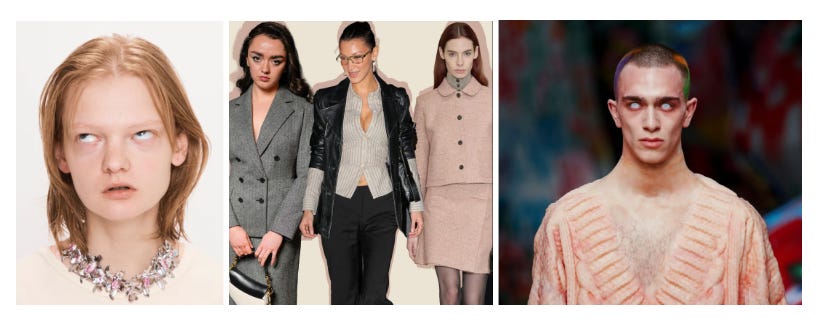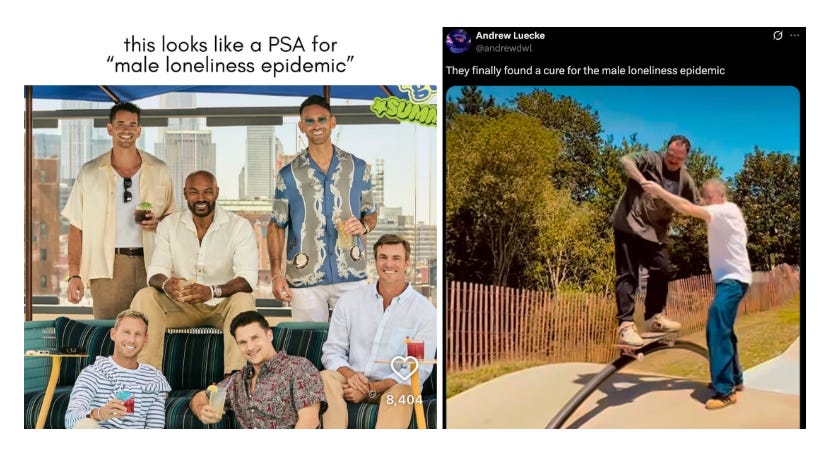The culture pendulum constantly swings. Generally though, it tends to skew slightly, leaning a bit more in one direction than the other but never in such contrast as 2025. In today’s cultural and political climate, the left wing radicals of yesteryear are swinging so far right, they’re sporting MAGA hats and praising tech oligarchs.
At 31 years old, I’ve lived through enough presidents, news of war, music genres, it girls and boys, tech advancements, micro-trends, and world changing phenomenas to have realized that yes it’s true, history does repeat itself, and yet, it feels both familiar and shockingly foreign.
The launch of this substack last year came from a disillusionment around career, success, purpose, and place. This year has been different. There’s still existential dread and delusional optimism, but accompanied by a numbness that is hard to shake. I know a lot of people feel similarly for many others, it’s the opposite. The constant tragedy-filled news-cycle has taken over the psyche and it’s reached an emotional tipping point.
The way I have come to work through this is paradoxical—a manic obsession with tracing the breadcrumbs through my perception of cultural history.
In an effort to make sense of the current chaos, and the different ways my peers and I are processing, I took a stroll down memory lane — piecing together the way we’ve experienced the eras of life in real time, hoping it might explain why everything feels like (a fucked up) deja-vu.
1993–1999:
Born into a world of rock’s new found heroes (Kurt Cobain, Eddie Vedder, Billy Corgan), hip-hop’s rise to mainstream recognition through superstar talent (Wu-Tang, 2Pac, Tribe Called Quest), and most notably, pre-9/11 innocence. The '90s were grungy but hopeful — a time when Bill Clinton was playing sax on late-night TV and getting his dick sucked in the Oval Office. Feminism entered it’s third-wave, riot grrrl was born, and “Girl Power™” was everywhere—from the graffiti’d walls of desolate punk houses to my own Lisa Frank Binder. Monica Lewinsky was a punchline, not yet a reclamation (or a brand ambassador with a podcast). The seemingly opposite films, Titanic and Jurassic Park, were the highest-grossing of the year (perhaps because of Y2k paranoia). We scream-sang No Doubt and Aaliyah, obsessed over Tamagotchis, and thought Neopets was height of digital sophistication.
2000–2010:
The millennium turned and so did everything else. 9/11 shattered the illusion of safety. The Bush years brought war, fear, and a new flavor of nationalism. Culture responded with irony (Napoleon Dynamite, Family Guy, The Office), rage (nu metal, Eminem), and eventually a sad-girl indie Tumblr aesthetic (Cat Power, Regina Spektor) by the end of the decade. New rap icons emerged through Lil Wayne and Nicki Minaj. Feminism? Still sorting itself out post-Sex and the City and pre-girlboss. MySpace gave way to Facebook. Paris Hilton walked so Kim K could run. Obama’s election in 2008 felt like the dawn of something, but that would eventually fade. Meanwhile, we were shoplifting from American Apparel and documenting our bad behavior for an audience of disaffected strangers.
2011–2019:
Identity became a brand, and branding became everything. Instagram influencers became the new celebrities. Everyone had a platform, and everyone lacked nuance. Pop feminism came in waves: Beyoncé at the VMAs , #MeToo, pastel-tinted girlboss capitalism. The Obama era gave way to Trump, and the pendulum swung with a vengeance. Safe spaces and cancel culture were the biggest topics of conversation. Thinkpieces became war zones. Pop culture became political and politics became a meme. Meanwhile, the music world gave us SoundCloud rap, the return of emo (again), and the birth of hyperpop. Everything felt like a revival, but no one agreed on what we were reviving.
2020–2024:
The glitch in the matrix. COVID cracked open everything — systems, psyches, friendships. Suddenly, wellness was both salvation and a scam. Conspiracies were mainstream. Identity politics took center stage: Instagram turned into a morality play, complete with black square posts, carousel infographics, and callouts in the comments. The George Floyd protests felt like a collective awakening, until corporations co-opted it and the momentum curdled into empty DEI statements (and thanks to the current administration, is now considered a crime…).
So now what? What will characterize 2025?
In 2024, I launched Limbo to address a problem (a quarter-life career crisis) in the hopes of finding some sort of peace or inspiration. This year, I plan to do the same, but with a new problem, one I believe is more universal—
How do we balance fatigue with interest? How do we share real feeling, especially in public and especially online, without the fear “of being cringe”? What are the things (Music! Culture! Art! Business!) that make caring crucial and where + how do we embrace it?
While it’s hard to make sense of much these days, there’s one thing that has defined the last two years—explicitly caring about something is blasé. Caring is uncool.
Today, lines are so blurred it’s hard to tell if you're in a Reddit theory thread or a Senate hearing. The left got tired and lost the plot. The right got aesthetic. Hippie fascists are real. Feminism is tradwives, OnlyFans, girl math (+ dinner), or militant celibacy. Enough about girls though! We’re in the midst of the “young male crisis” after all. Music is a total amalgamation of what was popular throughout the last 31 years — every genre at once, all the time, and somehow it works. (Here’s a playlist.)
All that being said, the cyclical nature of anything cool is a source of hope. If caring has reached rock bottom of the Trend Bell Curve™️, that means we can only go up from here.
I’ll admit, I first started this piece with an opposite hypothesis—that relevance in 2025 was measured in apathy. But after two separate dinners with two different groups of friends this past weekend, I was playfully debated by everyone at the dinner table.
“But look at TikTok!” my friend Caroline said. “It’s more unfiltered than ever! And people want to be cringe.”
My boyfriend chimed in citing Charli and Lorde as prime pop culture examples. Though, I didn’t 100% agree, each of them made good points.
At another dinner, my friend Casey, wasn’t as lighthearted, and rightfully so. The world, and what’s happening in it, is fucked up. We’re in an endless cycle of tragedy and it can often feel like everyone is either:
Ignoring it so as not to let it consume them
or cold hearted socio paths who literally do not care (fwiw I think this one is unlikely)
2025 has provided some examples of the omnipresent numbness but also slivers of care, some serious and some seriously low brow. They paint a picture of the ‘today’ 'I’m living in that led to writing this whole fucking substack, goddamn it!
Continuing the exercise of chronicling the zeitgeist I observe, I outlined some key moments of 2025.
Pete Hegseth IDGAF-ing so hard he uses Signal to drop bombs. The same app we use to buy drugs.
AI: A perfect robot to be your lover, therapist, employee, personal assistant. Need I say more?
Elon Musk and President Trump went from frat bro besties to keyboard warfare a la pop star feuds of the early oughts. Two of the most powerful men in the world behaving like pubescent teens—if that doesn’t say big feels, I don’t know what does!
Fashion is where apathy is best leveraged (and has been for many years). It’s just a little more on the nose in 2025:
Diesel and the Zombie Apocalypse as inspiration
The ‘Slacker Surrealism’ done best by Collina Strada, Ottolinger, AVAVAV
Corporate-Core tech bro minimalism and Office Siren: the new, and imo better, normcore.
Love Island’s Amaya (bless her lunar-sensitive heart) feels too much and gets emotionally iced out by the villa — and yet she’s the internet’s favorite.
Instagram’s algorithm favors the “i want to kms..jk!” meme and celebrities photo dumping tear-filled selfies sandwiched between private jet pics, Dinner at Nobu and a beach bod reveal.
But TikTok, arguably the more beloved of social platforms (actually maybe after substack), is pro raw emotion.
The “Young Male Crisis” lol. it’s all over Substacks, YouTube thumbnails, and cable news chyrons:“Where are the men?”, “The lost boys of Gen Z.”, “Young men are dropping out of society.” here’s the thing no one really wants to admit: It’s not just disillusionment. It’s apathy.
All of the above, including the young male crisis, is not silo’d. It’s affected all of us.
We’ve witnessed:
Mass shootings.
Economic collapse.
Climate dread.
Pandemic isolation.
The fall of many public role models.
We’re culturally numb and overexposed but I’m seeing the cracks of keeping up an unemotional facade.
In years past, we overshared on IG, cried on the subway, protested for something we truly cared about and believed it would make a difference. And yet…?? The optimist in me likes to believe it did—that in some twisted evolution of the butterfly effect, every effort, every ounce of care, has somehow pushed culture forward. The realist in me argues that with that logic, the opposite is also true.
After writing this, I don’t necessarily feel good. But, I also don’t feel the apathetic, passive indifference associated with so much of the last few years.
Like last year’s Limbo, I still plan to interview and capture people I admire. But, there will be new formats / installments. Think of Limbo 2.0 as a cocktail inspired by the many social media platforms to have graced our screens over the last three decades. Let’s see how it goes.
XD Rawr :D
Isadora
a








v much appreciated this trip down memory lane, and nodding in violent agreement. i'm so happy limbo is back!!!
WOW!! WHAT AN INSIGHTFUL TAKE !
Great observations. Your finger is on the pulse !!
You hit a lot of nails on the head!
IM STILL PROCESSING……..& now I’ll check out the playlist.😘😘I need it!!Heart Hugs💝💖💝💖
MANY BLESSINGS💫✨💫✨💫✨💫
LOVE❤️😘❤️😘your MOM